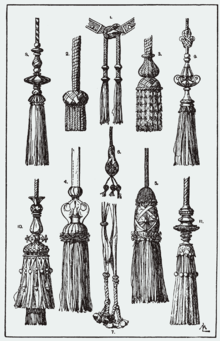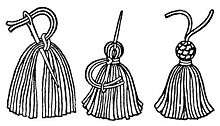Tassel
A tassel is a finishing feature in fabric and clothing decoration. It is a universal ornament that is seen in varying versions in many cultures around the globe.

History and use

_MET_DP155162.jpg)
In the Hebrew Bible, the Lord spoke to Moses instructing him to tell the Israelites to make tassels (Hebrew tzitzit) on the corners of their garments, to help them to remember all the commandments of the Lord and to keep them (Numbers 15:37-40), and as a sign of holiness. The religious Hebrew tassel, however, bears little resemblance to the decorative one which eventually became popular in Europe, especially France.
In the West, tassels were originally a series of windings of thread or string around a suspending string until the desired curvature was attained. Later, turned wooden moulds, which were either covered in simple wrappings or much more elaborate coverings called satinings, were used. This involved an intricate binding of bands of filament silk vertically around the mould by means of an internal "lacing" in the bore of the mould.
These constructions were varied and augmented with extensive ornamentations that were each assigned an idiosyncratic term by their French creators. In sixteenth-century France these individuals were called passementiers, and an apprenticeship of seven years was required to become a master in one of the subdivisions of the guild. The French widely exported their very artistic work, and at such low prices that no other European nation developed a mature "trimmings" industry. Many of the passementiers, however, were among the Protestant Hugenots who fled France in the 1600s to escape persecution, taking their tools and skills with them.[1] Tassels and their associated forms changed style throughout the years, from the small and casual of Renaissance designs (see example), through the medium sizes and more staid designs of the Empire period to the Victorian Era with the largest and most elaborate decorative flourishes. Some of these designs are returning today from the European and American artisans, who may charge a thousand dollars for a single hand-made tassel. The majority of the world's tassel production, however, takes place in China which mass-produces and exports them globally.
Tassels (also called tufts) were traditionally worn by Oxford and Cambridge University undergraduates on their caps, those wearing gold tassels were those who had paid for the status of gentleman-commoner, thus receiving increased social prestige and more luxurious accommodation than ordinary commoners who wore plain black tassels on their caps.[2] Today, only the Chancellor of Oxford wears a gold tassel.[3]
In the Middle East, tassels were worn as talismans, especially on headwear. In Egypt, Mesopotamia, and throughout the Arab world tassels were worn by children on hoods or caps to protect them from malevolent spirits and ward off demons.[4]
Ceremonial wear
In the U.S., tassels, or liripipes, are also found on mortarboards during university graduation ceremonies and possibly upon the shoes of the graduates at the ceremony. Near the conclusion of the graduation ceremony, the tassel that hangs from the graduate's mortarboard is moved from the right to the left. Typically, the entire graduating class does this in unison.
Creation

A basic key tassel is made by binding or otherwise gathering threads from cord protrudes on one end, where the tassel is hung. This may have loose, dangling threads at the other end. Tassels are normally decorative elements, and as such one often finds them attached, usually along the bottom hem, to garments, curtains, pasties covering the nipples of burlesque performers, or other hangings.
A tassel is primarily an ornament, and was at first the casual termination of a cord to prevent unraveling with a knot. As time went on, various peoples developed variations on this, until by the 16th century in France the first Guild of Passementiers was created and documented the art of passementerie. The tassel was its primary expression, but it also included fringes (applied, as opposed to integral), ornamental cords, galloons, pompons, rosettes, and gimps as other forms. Tassels, pompons and rosettes are point ornaments; the others are linear ornaments.
See also
References
| Wikimedia Commons has media related to Tassels. |
- Joanna Banham (1 May 1997). Encyclopedia of Interior Design. Routledge. p. 951. ISBN 978-1-136-78758-4.
- "The Chancellor - University of Oxford". Ox.ac.uk. Archived from the original on 2008-05-04. Retrieved 2013-11-19.
- Jenkins, Jessica Kerwin, The Encyclopedia of the Exquisite, Nan A. Talese/Doubleday, p. 213
- Guide to Passementerie. Scalamandre Silks. New York.
- Boudet, Pierre and Bernard Gomon, La Passementerie, Dessain et Tolra, 1981. ISBN 978-2-249-25108-5.
- Pegler, Martin, The Dictionary of Interior Design, Fairchild Publications, 1983. ASIN B0006ECV48.